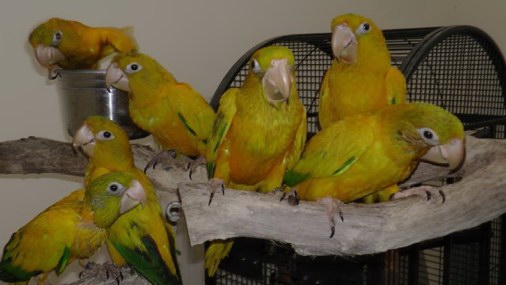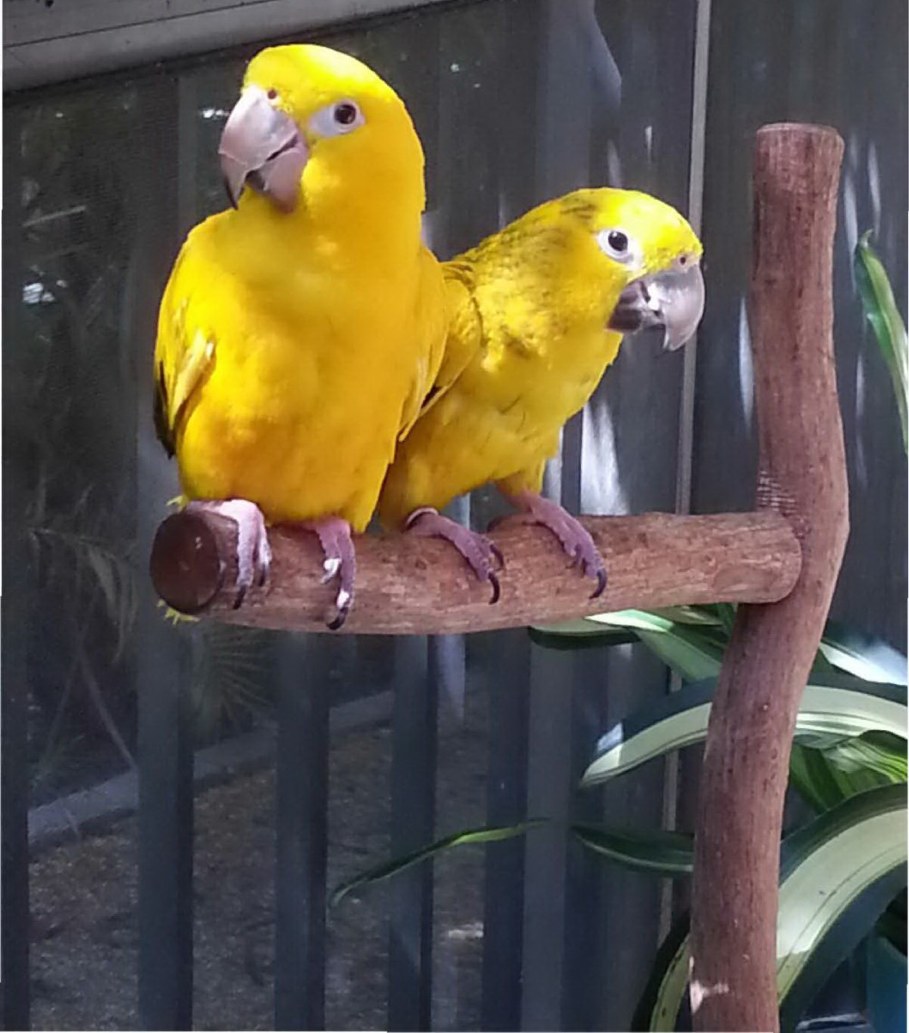QUEEN OF BAVARIA | home |
Scientific Name: Aratinga guarouba, renamed to: Guaruba guarouba)
Distribution:
The Queen of Bavaria Conure or Golden Conure is found in a remote area of northeastern Brazil. They have long been known to naturalists. A Dr. Greene is said to have described this bird as the Golden Parrot in a writing in 1887, and he advises that there was a specimen in the London Zoo since 1871. They were first bred in Sri Lanka in 1939, and in the United States in 1945.
Due to the destruction of thousands of acres of jungle, their native habitat has been drastically reduced. Today they are extremely rare and are protected. Even in captivity there are limited numbers and their status is very fragile. Keeping them in captive breeding programs has taken precedence hopefully with the aim of precluding any further need to collect them from the wild.
Description:
The Queen of Bavaria Conure or Golden Conure, a small member of the parrot family, is considered the most beautiful of the conures. They are a brilliant golden yellow with only the lower portion of the wings being green. They rather resemble a small macaw with a beak and head that is quite large, though they have a relatively short tail. The eye is brown surrounded by a naked white eye ring. The beak is a pale horn color and the legs are a light pink.
The young have green feathers in the plumage and the yellow is duller. They are fully feathered by 18 months of age.
Size - Weight:
The Queen of Bavaria Conure or Golden Conure will reach up to 14 inches (35.5 cm) and weigh 8.8 ozs (249 g).
Care and feeding:
A roomy cage is required unless the bird is to be let out for extended periods. Many birds can spend most of their time on a play pen or parrot perch. They eat a variety of sprouts, seeds, nuts, fruits, vegetables, and commercial pellets, as well as the same nutritional foods humans eat.
See About Conures: Housing and About Conures: Care and Feeding for more information.
Social Behaviors:
In the wild they were at one time seen in pairs or small groups of up to about 60 birds, though today fewer birds are seen. They love to play, especially climbing and chewing. They can also be rather noisy.
Breeding/Reproduction:
They breed readily in captivity and are not overly fussy about their nest, though they get quite aggressive to their keeper while breeding. If they lose their mate they are unlikely to pair with another.
The female lays 3 to 4 eggs which are incubated for about 25 days. The young fledge (leave the nest) after about 10 weeks though the parents continue to feed them for some time after that.
Potential Problems:
As with most Aratinga species, this bird can be noisy.
See About Conures: Potential Problems for information on illnesses.
Availability:
The Queen of Bavaria Conure or Golden Conure is not readily available as a pet, and is quite expensive. They cannot be sold between state lines in the United States unless both the buyer and the seller obtain a permit from the U.S. Fish and Wildlife Service.
Activities: Loves to climb and play. Provide lots of SAFE BRANCHES and perches.
Tbe Golden Conure is a CITES 1 and a ESA (U.S. endangered species) bird. It is often referred to as the Queen of Bavaria Conure.
QUEEN OF BAVARIA
Golden parakeet or Golden conure (Guaruba guarouba)
IUCN status: VULNERABLE
 Golden parakeet, also known as Golden - or Queen of Bavaria conures, are an enigmatic species of Neotropical parrots. It's the only member of its genus, Guaruba. They live in parts of northern Brazil, where they occupy two different habitats: tall forest during the dry, non-breeding season, and more open (farm)land during the wet, breeding season. The population size is very small, mostly due to habitat loss and extensive trapping for the pet trade. However, it might turn out numbers were greater than previously expected, so the species might be downlisted to Vulnerable. While the adults are a striking golden yellow with sap green flight feathers, juveniles are somewhat duller in colour with a green head and neck, and mixed green with yellow on the wing coverts, tail and back. Golden parakeets are a gregarious species, living in groups of 4 to 20 individuals. Ssome of the largest of all Neotropical parrots. They're also unique in their nesting behaviour, with a group of youngersters aiding in the rearing of the offspring. This behaviour is quickly dropped in captivity though, where youngsters are often abandoned.
My Nest Box Raised Golden Conures are in the CAPTIVE BREEDING WILDLIFE Program by USFWS at Heaven on Earth Avian Acre. I AM CBW registered ESA and Enhancement Act. $3000 ea. I am taking orders for future UNRELATED pairs with monthly payments available to secure great future breeding pairs for the conservation efforts. CBW PERMIT required for this conservation IF out of State. BOTH,buyer and seller must have this permit. Pet purchase out of state must comply with FEDERAL Interstate Commerce Service (ICS). One baby FEMALE possible (pending) All are DNA SEXED All are TESTED FOR Avian Borna virus and Polyoma Virus with result NEGATIVE.
I have been FLORIDA WILDLIFE CONSERVATION LICENSED SINCE 1990 EACH YEAR CONSECUTIVELY so my Parrots are ESTABLISHED. Palm Beach County tax receipt for Bird Sales.
|
